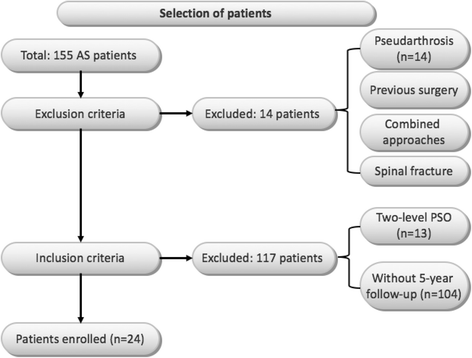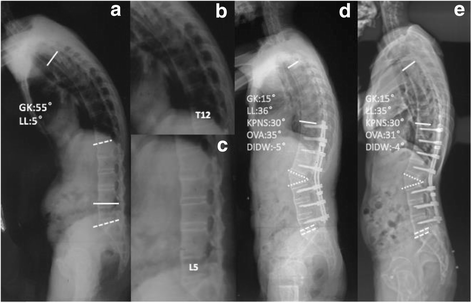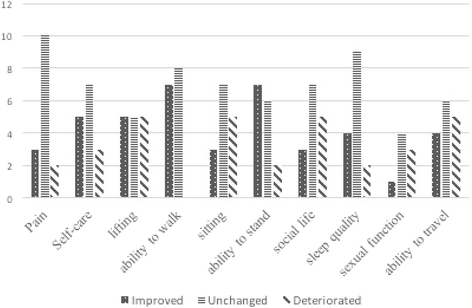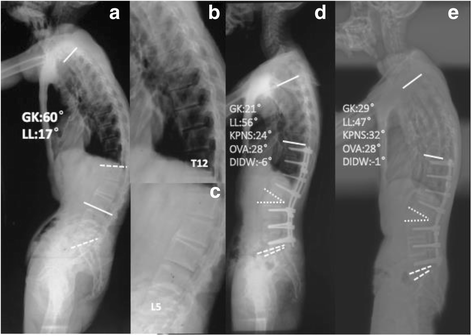The patterns of loss of correction after posterior wedge osteotomy in ankylosing spondylitis-related thoracolumbar kyphosis: a minimum of five-year follow-up
- PMID: 29149848
- PMCID: PMC5693535
- DOI: 10.1186/s12891-017-1834-4
The patterns of loss of correction after posterior wedge osteotomy in ankylosing spondylitis-related thoracolumbar kyphosis: a minimum of five-year follow-up
Abstract
Background: Short-term studies have demonstrated good surgical outcomes after pedicle subtraction osteotomy (PSO) in ankylosing spondylitis (AS) patients, but there is a paucity of literature focused on middle-term results, especially regarding patterns of loss of correction. The objective of this study is to assess the durability of surgical outcomes and the patterns of loss of correction in thoracolumbar kyphosis secondary to AS following lumbar PSO with over 5-year follow-up.
Methods: We performed a retrospective review of 155 consecutive AS patients undergoing lumbar PSO from January 2001 to December 2011. Twenty-four patients were included with an average follow-up of 6.9 years (range, 5-15 years). Radiographical evaluations included global kyphosis (GK), lumbar lordosis (LL), sagittal vertical axis, spinal-sacral angle, kyphosis of proximal non-fused segments (KPNS), angle of fused segments (AFS), osteotomized vertebra angle (OVA), distal intervertebral disc wedging (DIDW) and proximal junctional angle. Meanwhile, clinical outcomes were assessed by the Oswestry disability index (ODI) and Numerical rating scale (NRS).
Results: The average correction per PSO segment was 34.9°. Significant improvement in sagittal parameters were found postoperatively, and no obvious deterioration was noticed during the follow-up. Mild loss of correction in GK (2.82°) and LL (3.77°) were observed at the final follow-up (P < 0.05). The KPNS and DIDW increased from 26° and -5.0° postoperatively to 30° and -2.2° at the final follow-up (P < 0.05), respectively. In contrast, no significant diminishment was identified in OVA and AFS (P > 0.05). The ODI and NRS improved significantly from 20.6 and 6.6 preoperatively to 5.9 and 2.3 at the final follow-up (P < 0.05).
Conclusions: PSO is an effective procedure for treating AS-related thoracolumbar kyphosis and can maintain sustained surgical outcomes during the middle-term follow-up. The loss of correction was mainly attributable to non-instrumented segments without fully ossified bridging syndesmophyte in the thoracolumbar region instead of instrumented levels.
Keywords: Ankylosing spondylitis; Loss of correction; Middle-term; Non-instrumented segment; Ossification; Pattern; Pedicle subtraction osteotomy; Surgical outcome; Thoracolumbar kyphosis.
Conflict of interest statement
Ethics approval and consent to participate
This study was approved by the Medical Ethics Committee of Medical School of Nanjing University (the ethics approval number provided by the board was 2,011,052). Written informed consent was obtained from all patients prior to testing.
Consent for publication
Not applicable.
Competing interests
The authors declare that they have no competing interests.
Publisher’s Note
Springer Nature remains neutral with regard to jurisdictional claims in published maps and institutional affiliations.
Figures




Similar articles
-
What is the optimal postoperative sagittal alignment in ankylosing spondylitis patients with thoracolumbar kyphosis following one-level pedicle subtraction osteotomy?Spine J. 2020 May;20(5):765-775. doi: 10.1016/j.spinee.2019.11.005. Epub 2019 Nov 14. Spine J. 2020. PMID: 31734451
-
When Can One-level Pedicle Subtraction Osteotomy Obtain Satisfied Outcomes for Severe Thoracolumbar Kyphosis with Global Kyphosis ≥80° in Ankylosing Spondylitis: A Comparison with Two-level Pedicle Subtraction Osteotomy.Spine (Phila Pa 1976). 2021 Mar 15;46(6):E374-E383. doi: 10.1097/BRS.0000000000003800. Spine (Phila Pa 1976). 2021. PMID: 33620182
-
Does the preoperative lumbar sagittal profile affect the selection of osteotomy level in pedicle subtraction osteotomy for thoracolumbar kyphosis secondary to ankylosing spondylitis?Clin Neurol Neurosurg. 2018 Sep;172:39-45. doi: 10.1016/j.clineuro.2018.06.026. Epub 2018 Jun 28. Clin Neurol Neurosurg. 2018. PMID: 29966933
-
Combined percutaneous and open instrumentation for thoracolumbar kyphosis correction by two-level pedicle subtraction osteotomy in ankylosing spondylitis.Eur J Orthop Surg Traumatol. 2020 Jul;30(5):939-947. doi: 10.1007/s00590-020-02631-4. Epub 2020 Jan 24. Eur J Orthop Surg Traumatol. 2020. PMID: 31980911 Review.
-
Comparison of Smith-Petersen osteotomy and pedicle subtraction osteotomy for the correction of thoracolumbar kyphotic deformity in ankylosing spondylitis: a systematic review and meta-analysis.Spine (Phila Pa 1976). 2015 Apr 15;40(8):570-9. doi: 10.1097/BRS.0000000000000815. Spine (Phila Pa 1976). 2015. PMID: 25868095
Cited by
-
3D-Printed Laminae for Kyphosis in Ankylosing Spondylitis During Pedicle Subtraction Osteotomy.Orthop Surg. 2025 Jul;17(7):2038-2047. doi: 10.1111/os.70074. Epub 2025 May 22. Orthop Surg. 2025. PMID: 40405443 Free PMC article.
-
The clinical relevance of the presence of bridging syndesmophytes on kyphosis correction and maintenance following pedicle subtraction osteotomy for thoracolumbar kyphotic deformity in ankylosing spondylitis: a comparative cohort study.BMC Musculoskelet Disord. 2018 Apr 2;19(1):97. doi: 10.1186/s12891-018-2013-y. BMC Musculoskelet Disord. 2018. PMID: 29609565 Free PMC article.
-
Cervical, Thoracic, and Spinopelvic Compensation After Proximal Junctional Kyphosis (PJK): Does Location of PJK Matter?Global Spine J. 2020 Feb;10(1):6-12. doi: 10.1177/2192568219879085. Epub 2019 Sep 30. Global Spine J. 2020. PMID: 32002344 Free PMC article.
-
Comparison of loss of correction between PSO and VCD technique in treating thoracolumbar kyphosis secondary to ankylosing spondylitis, a minimum 2 years follow-up.J Orthop Surg Res. 2019 May 16;14(1):137. doi: 10.1186/s13018-019-1170-5. J Orthop Surg Res. 2019. PMID: 31097011 Free PMC article.
References
-
- Qian BP, Wang XH, Qiu Y, Wang B, Zhu ZZ, Jiang J, Sun X. The influence of closing-opening wedge osteotomy on sagittal balance in thoracolumbar kyphosis secondary to ankylosing spondylitis: a comparison with closing wedge osteotomy. Spine (Phila Pa 1976) 2012;37:1415–1423. doi: 10.1097/BRS.0b013e318250dc95. - DOI - PubMed
MeSH terms
Grants and funding
LinkOut - more resources
Full Text Sources
Other Literature Sources
Medical
Research Materials

